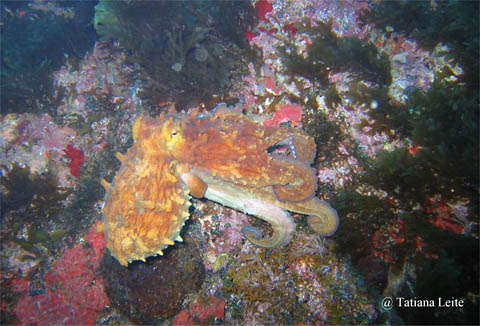
The medium-sized Octopus insularis was described based on material collected in shallow equatorial waters around the oceanic islands of Fernando de Noronha Archipelago, Rocas Atoll, St Peter and St Paul Archipelago, and the mainland of northeastern Brazil (Leite et al, 2008). This species is commercially important and accounts for a large percentage of octopus fisheries from Para (01o 28´N, 48o 29´W) to Bahia States (12o 56´N, 38o 31´W) in Brazil. This recently described species differs both morphologically and genetically from Octopus vulgaris in the Mediterranean, Venezuela and Southern Brazil. It has relatively short and stout arms, rugose reddish brown skin in preserved specimens, 8 to 11 gill lamellae on the outer demibranchs, small ligula, characteristic symmetrical radula, spermatophore and beak, small eggs and high fecundity (213000 oocytes under 1.5 mm diameter). The Octopus insularis diet in Fernando de Noronha Archipelago includes at least 55 species of crustaceans (70%), bivalves (17.5%) and gastropods (12.5 %); however, only 4 species accounted for half of the occurrences: the small crabs Pitho sp. (26.8%) and Mithrax forceps (23.9%), the bivalve Lima lima (5.3%) and the gastropod Pisania pusio (4.9%). The large proportion of two species of small crabs in den remains, the intense search for food during short hunting trips, and the intense use of cryptic body patterns during foraging trips, suggest that this species is a `time-minimizing` forager instead of a 'rate-maximizing’ one (Leite et al, 2009). Body colour of living animals in the environment varying from yellow to red-brown, usually cream-brown. The most common body patterns observed for this species were Mottle, Blotch, Dorsal Light-Ventral Blue-Green and Uniform Dark (Leite & Mather, 2008). It is found on reefs, bedrock, rubble, gravel and sand beds and rocky bottoms, regardless of the presence of algae, but never on sandy and muddy bottoms. Interestingly, Octopus insularis was the only octopus recorded in the minute St Peter and St Paul Archipelago (Leite & Haimovici, 2006). The low diversity of the Archipelago may be explained by its isolation, the small area of shallow water less than 50 m in depth (less than 0.5 km2) and poor diversity of habitats. It also suggests a higher adaptability of O. insularis to this environment when compared to other highly fecund tropical octopuses with small eggs. Futher studies, which are being carried out, may clarify this point.
No comments:
Post a Comment